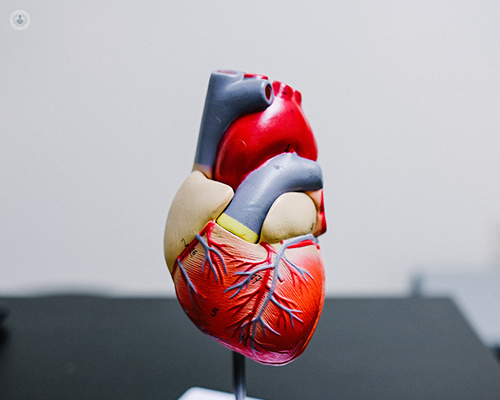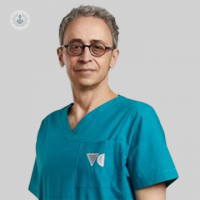How is a complex aortic disease treated?
Escrito por:Complex aortic disease is a vascular medical condition, often appearing without symptoms, that can lead to dangerous complications. Mr Michael Dialynas, expert consultant vascular surgeon, provides a comprehensive overview of complex aortic disease, explaining what are the different types, what treatments are available and when surgery is required.

What is complex aortic disease?
Complex aortic disease is a widespread term that describes a number of problems that people can encounter with the main blood vessel that supplies blood to all parts of the body, called the aorta. The aorta is the major blood vessel we have, it starts from the heart and once it enters the thorax, the abdomen is split into various vessels that supply all of the contents of the body: viscera, liver, spleen, kidneys, guts, legs. This is the driving force behind the blood supply.
The aorta can be affected by a number of problems and the most common ones are merely two types.
One is dilatation, that is, the abnormal enlargement of the vessel which has no specific cause in the vast majority of cases and which leads, in some patients, to a problem called an aneurysm, an abnormal dilatation of the main blood vessel. An aneurysm on its own is something that is not detected easily, simply because it causes no symptoms, it is normally found once patients have a test for no reason (it is part of the investigation to be screened as well) or if a patient is over the age of 65 as we have seen in the majority of parts in England.
An aneurysm on its own has no symptoms and has a tendency to grow in terms of dilating further. When it reaches a critical point, it can result in danger of bursting, with consequences for the body.
Nowadays, there are several treatments available for this problem, depending on the anatomy and the patient, too, because the treatments are designed not with the disease in mind, but with the patient’s aims. The first aim is to be the keeper of the patient’s life, the second is to ensure the patient is free (as much as possible) from the danger of rupturing, the third thing is that once we have finished with the treatment and the patient goes back to their normal health status, there will be no point treating anybody with a technically perfect procedure if the patient becomes significantly impaired afterwards and suffers as a result of the treatment. Everybody’s treatment is tailored to their specific needs and these include age, morbidities, medical conditions, what patients want to achieve and the kind of life relief.
There are a number of ways of treating this. We can have keyhole surgery, which is the endovascular - as we call them - option, but it can range from anything which is an official device that can be implanted in a patient to treat the aneurysm, or custom-made devices for more complex problems which involve part of the vessels that supply the viscera in the abdomen.
Treatment has progressed a lot in the last 10 years. I, for example, work in a centre where we perform a lot of these procedures yearly in Europe, so everything is available in the latest expertise to deal with these types of problems.
The second part of the aortic disease is occlusive disease. As some people become more experienced in life as we grow older, atherosclerosis occurs, referring to the hardening of the vessels. Vessels have deposits of calcium and lipids and they can narrow, in which blood supply to the legs mainly, but also to the gut or kidneys, is reduced. As it reduces, there comes again a critical point where there are consequences, of which the commonest is patients not being able to walk very far. This is called claudication and even though there can be a number of causes behind this, the most common one is the firming up of the vessels. This can start in the aorta and spread down to the legs or it could be solely confined to the legs, with the end result involving patients not being able to walk very far, causing distress. At the end stages of the disease, patients can have diminished blood supply to their legs up to the point of ulceration, pain at night and a significant reduction in walking distance, causing everyday life to be affected.
There are various treatments for this problem which are completely designed for the individual; not with the disease in mind, but thinking about the individual or about providing stalemate bespoke solutions for everyone. It comprises of a number of open and endovascular surgery – keyhole, balloons, stents – as well as tools that the modern vascular surgeon has available to solve these problems. The aim here is to improve the patient's quality of life and improve their walking distance or their life experience, rather than making promises that cannot be delivered and creating conditions as if the patient was 15 or 20 years old again, which is not going to happen in the majority of cases.
What are the symptoms of aortic problems?
Aortic disease and aneurysm are not symptoms: patients have no symptoms. All that happens is that patients come to hospital for a separate reason and then they suddenly end in cardiovascular surgery being told that they need an operation which has significant consequences, including death and loss of limbs. It is very difficult, sometimes, for patients who feel perfectly fine to digest this and that is why I use several images, scans and stents to show how the surgery is done, what is done and why it needs to be done. Patients are satisfied and tend to understand, once you give them these explanations.
With occlusive disease, patients will usually experience difficulties with walking and a reduction in the length of the distance they can cover, with this being worse with an incline. Patients start getting bothered once these difficulties affect their everyday life, for example if they are going to do their local shopping and they simply cannot do that without stopping. Some patients choose to ignore these difficulties for some time and believe it to be a normal part of ageing, which is not.
In extreme cases, patients have ulcerations, which are spontaneous wounds in the legs that do not heal, as well as pain in the night especially in the toes, feet and calves.
Are aortic problems serious?
They can be. If you have a large aneurysm, it can be serious, because as a growing bulge, there are certain sizes where the rupture rate can be quite high. In that case, some patients compare it to sitting on a time bomb dock, which is not exactly accurate. Rather, it is a measurable danger, especially if somebody is fit enough for treatment.
As for occlusive disease, occlusive disease on its own affects the quality of life of patients when they are walking. As things get worse, there are certain dangers with patients losing legs or developing ulcerations that cannot be healed. If things are delayed, sometimes there is a risk of irreversible schemas, in which fissures in the legs become so deprived of blood supply that even with treatment, the damage has already been done and the legs cannot return to their original functional status.
All these treatments have various levels of involvement with the patient, various levels of treatment and various degrees of what can be offered and what can be achieved. The aim is not always perfection, but to improve the quality of life of patients without putting them in danger. It is always a balance.
What types of treatments are available?
There are many treatments available nowadays, which span from single keyhole surgery when we do angioplasty, where we put a balloon inside the body and stretch the vessel to build a better channel for the blood to flow through that is done in some cases with local anaesthetic, to any major open surgery.
The vast majority of cases end up in surgery. We have a combination of open and endovascular surgery that has actually been proven to be a good combination of treatment with very good results. This means that even if patients end up in the operating table, not everybody will need an operation. Patients can improve their condition themselves by doing a number of things like controlling the risk factors - stopping smoking, taking antiplatelets and aspirin, controlling their lipids, changing their diet and exercising – which sometimes have paramount importance for patients with peripheral vascular disease and occlusive vessels, because the body is a remarkable organ which manages to repair itself by creating new blood vessels around existing blockages. Patients can enhance this feature by controlling the factors that slow it down and, at the same time, increase it by exercising, which is the best mechanism to improve blood flow to the legs. In conclusion, not everybody will need surgery as there are treatments available at all levels for all patients, with satisfactory results.
When is surgery required?
There are specific reasons why patients should have surgery, which will have complications no matter the type of surgery. Although these are very few with today’s technology and experience, some patients will still experience them, however. This is why I will always ask patients (patients sometimes insist on having treatment), to put themselves in a position where they are part of this small percentage that may experience complications, which include losing the leg. My recommendation is always in conjunction with a patient’s family as to what I think is appropriate for the patient, the level of disease and the level of activity of the patient. What is best, in my opinion, requires a lot of time.
However, some patients will need surgery. This depends on the level of disease they have, what can be achieved, what is holistically feasible and how fit they are, because a peripheral vascular disease is normally a manifestation of a disease that has spread throughout the body. Patients will have disease in the coronary vessels and those who smoke, will sometimes have lung issues as well. Overall, this has an impact on what surgery can offer.
Patients who go for major surgery with me always get a formal review by a medical consultant to go through every single aspect of their health, making sure they are in top condition or at least that, if they need treatment, we can ask different specialists such as cardiologists to intervene, improving heart flow and lung condition as much as possible for surgery if that is what is required.
We develop an ongoing relationship with patients who have these problems. It can be a one-off event, but it is usually a long-term relationship where patients get discharged and asked to come back after other issues develop. However, if patients are diagnosed early, the vast majority will have a good outcome. There are still some who do not have a good outcome, because there are diseases we cannot always fully treat, for example if there is narrowing of the vessels.
We have to be realistic with patients and set the expectations right, otherwise there can be disappointment. We should promise to try and achieve what is feasible and what is required for the specific patient.
Mr Michael Dialynas is a London-based expert consultant vascular surgeon with specialism in a variety of conditions including varicose veins, complex aortic diseases and leg ulcers. If you have recently been diagnosed with a complex aortic disease and wish to consider your options, make sure to visit Mr Dialynas’ Top Doctors profile today.


